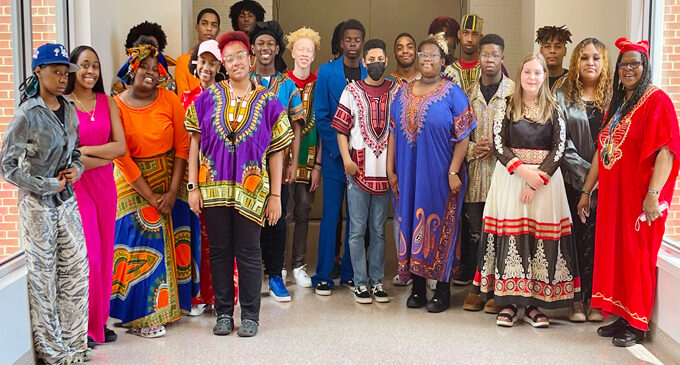Carver High School theatre arts students sponsor Black is Beautiful fashion show

Twenty-five Carver High School students from Felecia Piggott-Long’s theatre arts classes and Austin Warner’s heath class participated in the “Black is Beautiful” fashion show on Thursday, May 12, in the school cafeteria. Former models Joseph Anderson of New Breed Models in New York and Valjean Griggs of Troyann Ross Modeling Agency in Charlotte and of Ricky Wilson’s Fashions in Winston-Salem assisted the students with the lineup.
Audience participation was high, and other students and staff members, as well as Principal Thyais Maxwell, joined them on the dance floor.
“The Black is Beautiful fashion show was a great cultural experience for our staff and students. Our students looked amazing and brought the culture and vibe that was so rich in the ‘60s and ‘70s to 2022! We are grateful to Dr. Piggott-Long for hosting this wonderful event for Carver Nation!” said Dr. Maxwell.
Senior KeSean Samuel, Carver drum major, came down the aisle marching with his mace in his hand. “I just enjoy moving and being hype! If I can be hype and get everybody involved, it is exciting,” said Samuel. “I did a split in the middle of the floor. I just remix what I observe other drum majors do, like the one at A & T, and then put my spin on it. It just gets everyone lit.”
“It was a phenomenal display of culture and a wonderful introduction for some students to the cultural variety,” said Warner. “They had fun. It looked like a party in the cafeteria – that’s culture, Baby! It was beautiful!”
“It was encouraging to see young people modeling fashions from the Sixties and the Seventies. These were my modeling years,” said Griggs. “I also modeled for Coca Cola as a Fresca Girl.”
“I was pleased to see so many young people wearing the dashiki. When I modeled with the New Breed Models in New York, I remember that Jason and Mable Benning, the founders of the company, popularized the dashiki in America during the 1960s and the 1970s,” said Anderson. “The dashiki was considered a warrior’s garment.”
The word dashiki comes from the Yoruba word “dansiki,” which means “loose-fitting shirt.” Various companies fostered the cultural appropriation of this garment across the African landscape and throughout the African Diaspora. The civil rights and the Black Power movements of the 1960s and the 1970s gave the dashiki much political potency. Wearing the dashiki is a means of rejecting Western cultural norms and embracing this emblem of Black pride. The dashiki is a radical garment.
The dashiki was at the center of attention during the show. The models wore dashikis of various colors – red and white, lime green, purple and gold, orange and black, and green – just to name a few. Other highlights included bling-bling tops and shiny palazzo pants, and polyester bell bottom suits of orange and royal blue. Female models were dressed to the nines in African attire, headwraps, floor-length skirts and dresses, dashiki dresses, dashiki tops, and bodysuits. They also wore dresses from China and India that interventionist Fran Bussey and Piggott-Long donated to the show.
The Black is Beautiful fashion show is a follow-up to the tour of the Reynolda House Museum of American Art “Black Is Beautiful” photography exhibit of Kwame Brathwaite during Black History Month. Piggott-Long sponsored the field trip to the museum and visited the exhibit ten times. She had a dream about seeing her students modeling in these colorful garments. The fashion show was a natural sequel to the field trip.
“A dream without a plan is just a dream, but since the students and the teachers carried it out, it was more than just a dream,” said senior David Fields.
This photography exhibit tells the story of a central figure of the second-wave Harlem Renaissance. In addition to his photography, Brathwaite documents two organizations he co-founded – The African Jazz-Art Society (artists, playwrights, designers, dancers, etc.) and the Grandassa Models. Jazz is a music genre that originated in the African American communities of New Orleans, Louisiana, and the United States in the late 19th and early 20th centuries, with its roots in blues and ragtime. The origins of jazz go back to the blues, ragtime, spirituals, folk music, marches, and West African music. The models celebrated African American standards of beauty.
Hector Mendoza, data manager, observed the fashion show during all three lunches.
“It went very well. The kids had lots of fun. The African Americans and the Hispanic students were eager to participate,” Mendoza said.
School counselor Arneathia Brown said, “I just loved the beautiful colors of the dashiki, and I appreciated the willingness of the students to participate. Also, Dr. Piggott-Long was so involved, and they were glad to take the runway.”
Counselor Kenneth Brown considered the fashion show to be “a way of embracing the past in order to reshape the future.”










